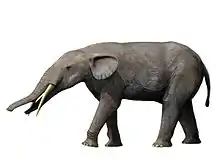1837 in paleontology
Paleontology or palaeontology is the study of prehistoric life forms on Earth through the examination of plant and animal fossils.[1] This includes the study of body fossils, tracks (ichnites), burrows, cast-off parts, fossilised feces (coprolites), palynomorphs and chemical residues. Because humans have encountered fossils for millennia, paleontology has a long history both before and after becoming formalized as a science. This article records significant discoveries and events related to paleontology that occurred or were published in the year 1837.
| |||
|---|---|---|---|
|
Archosauromorphs
Newly named dinosaurs
Data courtesy of George Olshevsky's dinosaur genera list.[2]
| Name | Novelty | Status | Authors | Age | Unit | Location | Notes | Images |
|---|---|---|---|---|---|---|---|---|
| Gen. et sp. nov. | Valid | Christian Erich Hermann von Meyer | Late Triassic | Feuerletten Formation, Fleming Fjord Formation, Knollenmergel, Marnes Irisees Superieures Formation, Obere Bunte Mergel Stubensandstein, Trossingen Formation | German paleontologist Hermann von Meyer formally named and described Plateosaurus. This was the first described prosauropod, and is still the one we know most about.[4] |  | ||
Synapsids
Afrotherians
| Name | Status | Authors | Age | Location | Notes | Images |
|---|---|---|---|---|---|---|
|
Valid |
Burmeister |
Early Miocene to Early Pliocene |
|
A gomphothere. |
||
References
- Gini-Newman, Garfield; Graham, Elizabeth (2001). Echoes from the past: world history to the 16th century. Toronto: McGraw-Hill Ryerson Ltd. ISBN 9780070887398. OCLC 46769716.
- Olshevsky, George. "Dinogeorge's Dinosaur Genera List". Retrieved 2008-08-07.
- Meyer, H. von (1837). "Mitteilung an prof, Bronn (Plateosaurus engelhardti)". Neues Jahrbuch Mineral Geol. Palaeontol. 1837: 317.
- Farlow, James O.; M. K. Brett-Surmann (1999). The Complete Dinosaur. Bloomington, Indiana: Indiana University Press. p. 11. ISBN 0-253-21313-4.
This article is issued from Wikipedia. The text is licensed under Creative Commons - Attribution - Sharealike. Additional terms may apply for the media files.

